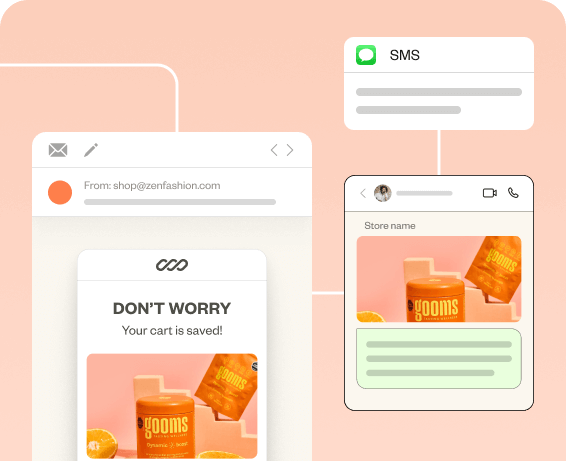If you want to stand out in your customer’s inbox, it’s time to update your email marketing strategies.
As an online business owner, you already know the importance of email marketing. Nothing can ever replace that. But your customers’ needs do change, and you have to keep up with those dynamics.
We know your main email marketing goal is to improve customer engagement and retention rate. For that, you would need effective email marketing strategies to engage customers and keep them hooked without overwhelming them.
In this blog, we lay out effective and practical strategies to help your emails engage, convert, and generate profit.
Improve customer engagement and campaign performance with personalized and automated emails of Retainful.
19 Effective Email Marketing Strategies to Create Successful Email Campaigns
Let’s take a look at effective email marketing strategies that would instill brand loyalty, improve customer experience, and increase customer engagement and ROI.
1. Know your audience
It is the very first step of email marketing. You must know the preferences of your audience, but you have to be non-intrusive.
Try progressive profiling, where you gradually gather details without overwhelming customers with extensive email sign-up forms. This creates a positive and personalized experience and easily increases email open rates.
Create sign-up forms to capture email address and other data like first name, preferences, and phone number.
2. Set campaign goals
To set email campaign goals, first define the purpose of your email campaign, whether it’s to
- Drive sales
- Increase brand awareness
- Nurture leads
- Gather feedback
For e.g., you can send a welcome email about your brand and its values to new prospects or an email with exclusive offers to build customer loyalty.
Also, don’t forget to set specific email marketing metrics to measure your progress, such as achieving a certain conversion rate, increasing click-through rates, or growing your subscriber list.
Regularly monitor and analyze key performance indicators (KPIs) to assess progress and adjust your strategies for a successful email marketing campaign.
3. Maintain a clean email list
Will a clean email list increase open rates and response rates? The short answer is – yes, it would.
The long answer is that an email list with invalid or non-existent addresses increases bounce rates which occur when the email cannot be delivered to the right recipient.
You don’t want that because it signals your ISP (Internet Service Provider) that your email marketing campaign is substandard, which will negatively impact your sender reputation.
To prevent this, perform email validation to weed out invalid email addresses to maintain your sender reputation and avoid getting marked as spam.
The best part about this is that you don’t have to pay for contacts who are no longer interested or whose emails are undeliverable, which makes your marketing email strategy more cost-efficient.
Related Reading: Learn how to do e-commerce email marketing with top strategies in our blog: E-commerce Email Marketing: Strategies + Software
4. Email list segmentation
You can’t skip this email marketing success tip if you want your emails to be more relevant and increase the engagement rate.
Receiving irrelevant content is the most common reason for unsubscribing. When subscribers receive emails that speak directly to their needs and based on their stage in the email marketing funnel, they are more likely to convert into customers or take the desired actions.
There are many email marketing tools out there that would help you with email segmentation in an email based on demography, psychography, geography, and customer life cycle stage.
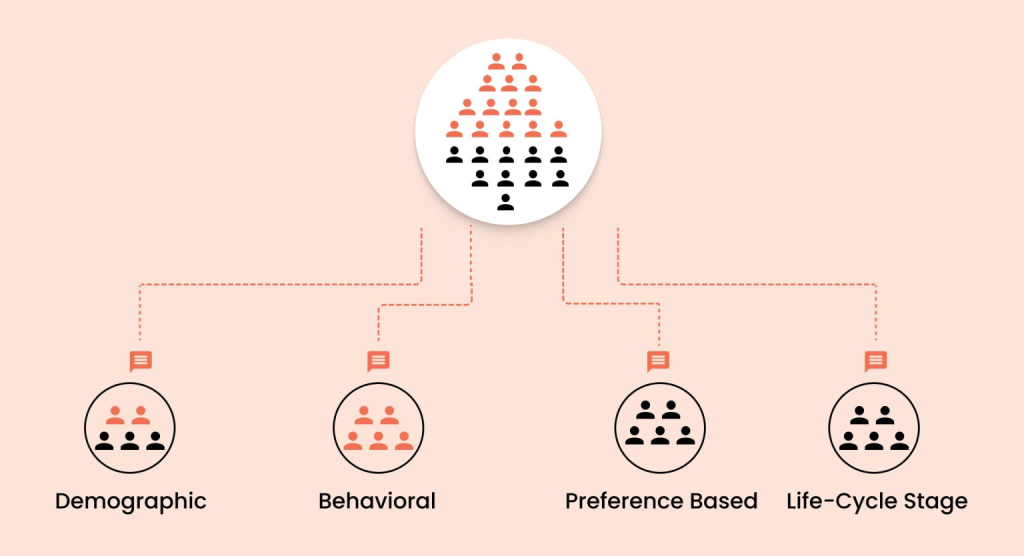
Helpful Tip: If you are acquiring your email list from your websites and platforms, you can make use of their information to personalize the emails further. For example, you can use session logs to track users’ public IP addresses and use an IP lookup tool to find their general location. Then, you can localize the content according to their region to make it more impactful. This is a rare and niche tip that can work wonders if you use it right.
5. Personalization
Email personalization is a cornerstone when it comes to email marketing strategies. Now that you know how email segmentation works, the next step is to personalize your emails using dynamic content, personalized subject lines, and salutations to establish a one-to-one connection.
Also, leverage behavioral triggers for automated campaigns based on specific user actions, such as making a purchase, abandoning a cart, or clicking on certain links.
Striking the right balance in timing and frequency adds another layer of personalization. Automate your emails based on the recipient’s behavior. For instance, if a user typically opens emails in the evening, schedule your messages accordingly.
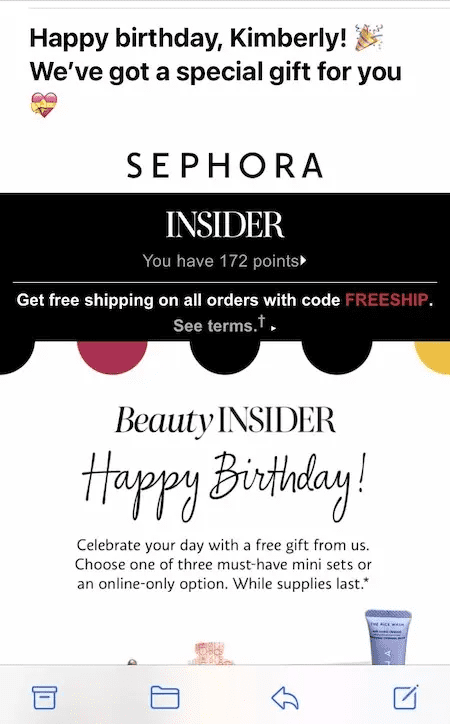
Takeaways:
- The customer’s name is at the top of the template.
- Insider points are highlighted followed by the customer’s name.
- A template made specifically for the customer’s birthday.
Related Reading: Explore the best-personalized email marketing examples by top brands in our blog: 15 Best Email Marketing Examples For 2025
6. Mobile-optimized emails
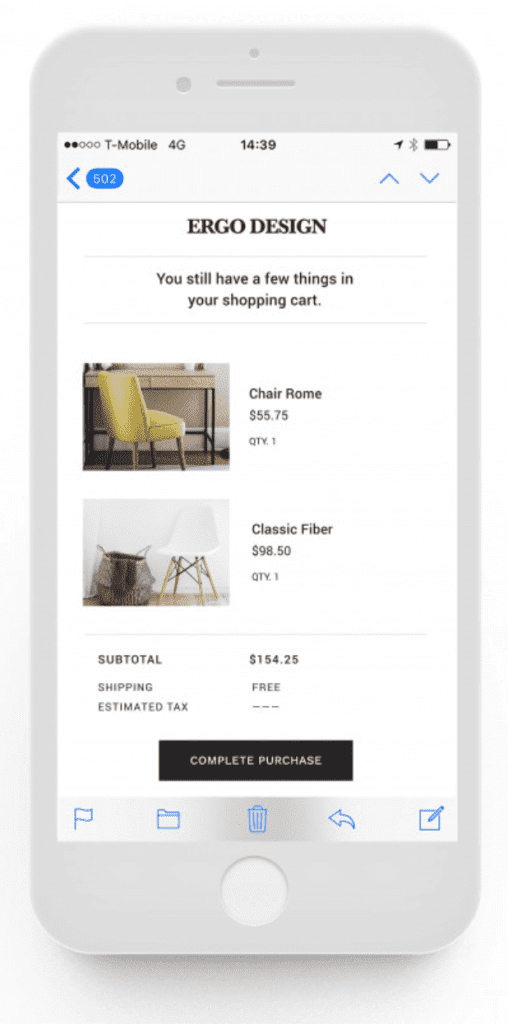
Most customers have only their work email addresses on their laptops. Their personal email addresses are going to be on their mobile. You need to prioritize customer experience here and create emails with responsive email design that adapts to different screen sizes. This automatically gives you higher click-through rates.
Also, when you implement this email marketing strategy, you reduce your email loading time and minimize the chances of your customers abandoning your email.
7. Attention-grabbing subject line
One of the most effective email marketing strategies that will help you instantly with open rates is the subject line. It’s the first thing your customers see when receiving your email.
At any given time, your customer’s inbox will be crowded. Your email is going to compete with all of those other emails.
Think – compelling, prompting immediate action, positive first experience. This is the formula to create a subject line that will encourage customers to open the email.
Be mindful of the mobile users when writing subject lines because of the limited screen space. Aim for short and impactful subject lines.
8. Time it right
If you want to see a surge in your email open rate, then you must know the best time to send marketing emails. Analyze when your customers are more likely to open your emails using the analytic features of your email marketing tool.
Emails for B2B lead generation perform better when sent on weekdays during business hours when professionals are more likely to check their work emails. On the other hand, B2C emails, especially those related to leisure or shopping, might see higher engagement during weekends when people have more free time.
Sending emails too frequently or during peak unsubscribe times (such as during late evenings or early mornings) may make subscribers annoyed and opt out of your email list.
For instance, sending promotional emails during peak shopping hours or before a weekend can increase the response rate. A flash sale email sent with urgency during lunch breaks might prompt immediate action.
Understanding your audience’s habits ensures emails arrive when they’re likely to be noticed. If you are unsure, A/B test your email timings to be sure of the right time to reach customers.
9. Write concisely and engagingly
It is important to write your email copy concisely to keep things easy to read for the customers. Look to highlight the key elements in the discussion centered on your CTA (more about that later.)
Empower yourself by using a paraphrase online tool to bring engagement to your email text. The paraphrasing tool, powered by AI algorithms, quickly understands your text and its context. It then recreates your content, enhancing its appeal and captivation. With AI paraphraser tools, you can confidently improve your email content.
However, it is understandable that many don’t understand the writing techniques involved in condensing a text for better readability. Hence, using a text summarizer can be crucial for this task. The advanced tool leverages NLP algorithms to strip down input text to the fundamentals. So you can get more engagement for your messages.
10. Strategic CTAs
CTA is an email marketing strategy that guides your users to the next desired step. You are supposed to place it after showing your users what value you have to offer them.
You can use more than one CTA, but just make sure they all provide different values. For example, an e-commerce email might feature a CTA like “Shop Now” for a new collection, while a newsletter could use “Read More” to encourage further exploration. CTAs get you higher Click Through Rates if you know how to place them.
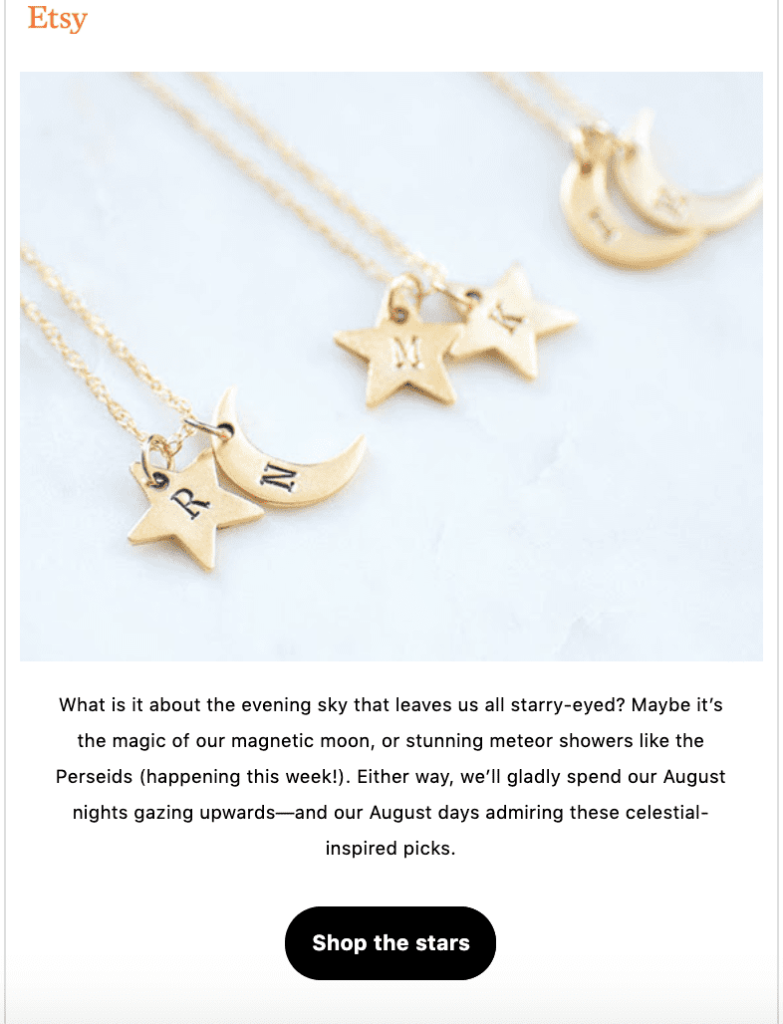
The image is attractive and conveys instantly what the email is about and the email copy explains what the jewelry collection is about. Notice how the email flows into the CTA with action-prompting words that direct customers to click on it? That’s strategic CTA placement.
11. Using email marketing automation tools
You can’t make it far if you send your emails manually. It’s a well-known fact that you can save a lot of time with email automation that sends trigger-based emails. But are you sure you have the right email marketing software? Are you positive that you are not missing out on any features?
Here’s a small checklist you can use to make sure you have the right email automation tool.
- Automated workflows: Customizable email automation with automation triggers, wait, entry, and exit conditions.
- Customizable templates: ability to modify the templates for images, content, font, and basically all aspects to make it relevant to your brand.
- Email list segmentation: must allow segmentation based on various criteria such as demographics, shopping behavior, or purchase history.
- Analytic dashboard: must provide insights into conversion rates, open rates, click-through rates, and other key metrics.
12. Attractive email templates
The quickest way to impress your customers is by sending a visually appealing email. A well-designed email template conveys a sense of professionalism and credibility. They give the impression that the sender has invested time and effort into creating a polished and thoughtfully crafted message.
Also, when you use templates with consistent branding elements, such as colors, logos, and fonts, reinforces brand identity. Consistency across communications helps build brand recognition and fosters a sense of familiarity and trust.
Always aim to give a structured layout because clear and organized information is more likely to be absorbed by the audience. Additionally, responsive email design ensures that the email looks good and is easy to read on various devices.
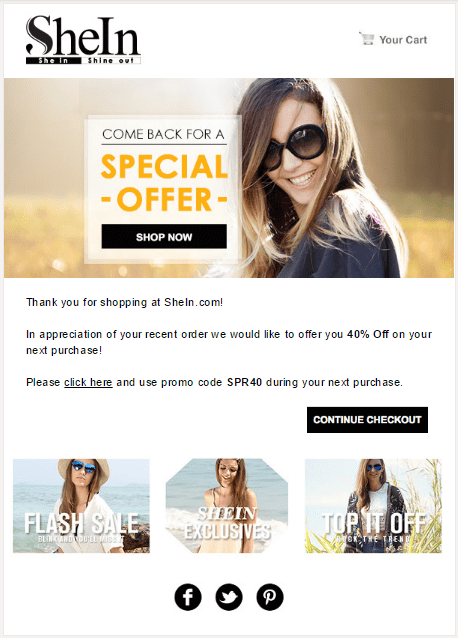
Take a look at this She In’s email template that has packed everything possible to make the customer want to place another order.
Takeaways
- The “your cart” link at the top of the template.
- The special offer announcement in big, bold font.
- A short thank you message followed by a 40% discount.
- A clear CTA to the checkout page and 3 more categorized CTAs.
- Social media handles at the end of the template.
- A clear and uncluttered template designed with not too many crowding elements.
Related Reading: Discover the 10 best email marketing software in the market and their comparison in our blog: 10 Best Email Marketing Software for 2024
13. Use the right visuals
Would you remember that funny gif or the plain text email? Of course, everyone would remember the visuals better.
Visuals communicate complex information more efficiently than text alone, helping customers quickly grasp key messages. It improves customer experience and, ultimately, customer engagement.
One of the best ways to capture the viewer’s attention is by using high-quality and relevant images. A visually appealing image can entice the audience to explore the content further.
Videos offer a dynamic way to tell stories, whether about the brand, product, or customer experiences. Storytelling through videos can create a more immersive and engaging narrative.
GIFs are short, looping animations that add a touch of visual interest without the commitment of a full video. They are particularly effective for conveying emotions, demonstrating quick processes, or adding a fun element to the content.
14. Leveraging Social Media
Find a way to incorporate social media accounts in your emails because it is one of the efficient email marketing strategies that would give you an extended reach. This strategy encourages customers to connect with your brand on multiple platforms and fosters a richer relationship. It’s a simple way to build brand awareness and maintain brand consistency while promoting special offers and events.
By leveraging social media, you open doors to user-generated content, community building, and real-time updates. Social media also serves as a direct communication platform, providing valuable feedback and insights from your audience.
15. Contests and Giveaways
One of the retention email marketing strategies that engages customers and keeps them loyal to the brand is running contests and giveaways. They enhance your open and click-through rates by leveraging tempting prizes, usually just asking for an email address in return. This easily helps grow your contact list. And guess what? When people share the contest on social media, your brand’s fame gets a boost, reeling in new fans.
Contests aren’t just about prizes; they’re a cool way to get customers involved, form real connections, and build loyalty. And here’s a nifty trick: team up with other brands for contests to cross-promote and reach even more audiences.
Related Reading: Find out ways to increase customer stickiness for your business: 6 Brilliant Ways to Increase Customer Stickiness for your Business
16. Track Metrics
Tracking email key performance indicators (KPIs) like open and click-through rates is crucial for optimizing your marketing email strategy. Observing KPI over time becomes your guide in shaping your content strategy, tweaking elements like subject lines, and calls-to-action to yield better results. They help you ensure the health of your email list and prompt regular clean-ups for optimal reach.
Conversion rates, another vital email marketing KPI, provide insights into your campaign’s success, while ROI calculations justify your investments. This data-driven approach guarantees continuous improvement, ensuring your email strategy evolves based on insights gained from each campaign.
17. A/B Test your Email Marketing Strategies
A/B testing is comparing two versions of your email to figure out the best version. When you play around with different content, personalization, timing, and design, you get to know what really clicks with your audience.
A/B testing takes the guesswork out and shows real insights, leading to higher open and click-through rates. And it’s not just about the basics – we’re talking about testing everything, even the design of your call-to-action, so that you can nail those conversion rates.
A/B testing isn’t just about quick wins. It creates a culture of learning and improvement. So, you keep refining your strategies based on what works best, making sure your email marketing campaign strategies match your subscribers’ real-time behavior and preferences, and that’s how you max out your return on investment!
18. Address inactive subscribers
Just like you understand the significance of strategic email marketing campaigns for your online business, addressing inactive subscribers is also crucial. It’s not just about maintaining list health, optimizing sender reputation, and improving deliverability – it’s about focusing your resources where they matter most.
Whether you choose to re-engage inactive subscribers, this proactive approach enhances cost efficiency, directing your efforts to a more engaged audience. Keeping your list up-to-date ensures better targeting and personalization, leading to more effective email campaigns.
Send a series of win-back emails to reactive customers and clean the inactive customers at the end of the campaign.
19. Email Design Best Practices
Here’s a quick guide to designing emails that would align with the needs of your brand and customers and get you the best outcome from email marketing.
Subject lines: Keep only necessary words. Aim to create curiosity. To be on the safer side, use only up to 9 words.
Responsive design: Your design should shrink and enlarge based on the screen size of the device.
Color: Stick to your brand’s aesthetics. Pick a background color that would go with the images and the font color you are going to use.
Font: Do not use more than two fonts. Aim for a base font size of 14-16 pixels for the main body text. Use larger font sizes for headings (H1 to H6). For example, H1 can be around 22-28 pixels, and subsequent headings can decrease in size.
Images: Choose images that enhance the overall narrative. Optimize image file sizes to ensure fast loading times. Maintain a consistent visual identity by using images that align with your brand’s colors, style, and overall theme.
Call to action: Make your CTA visually stand out by using contrasting colors. Position it prominently within the email, typically towards the top or center, where it’s easily noticeable. Consider adding subtle hover effects to the CTA, such as a change in color or a slight shadow, to indicate interactivity.
Layout: Consider using a single-column layout for simplicity and easy mobile responsiveness. If you have a variety of products and content to showcase, multiple columns can be used. Use whitespace effectively to avoid visual clutter and make your email more readable. Include a navigation bar or menu that provides links to different product categories, making it easy for users to explore.
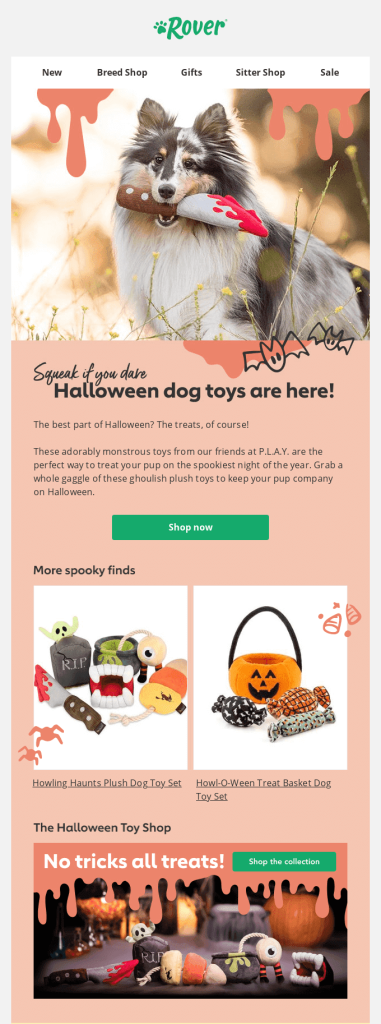
Rover Pet Store has nailed the email template design with everything necessary to convey its seasonal sale.
Takeaways:
- The visual appeal of the template conveys the Halloween theme.
- The image of the dog with the plush toy narrates the whole point of the email.
- The spooky font is used sparingly so as not to make it overwhelming.
- The color aesthetic and font size changes increase readability.
- The standout color of the CTA.
Get started with Retainful for effortless automation and customization to increase your email ROI.
Conclusion
The one thing you must not ignore when you are sending an email is “being customer-centric.” All of the above-stated best email marketing strategies are aimed at being customer-centric, improving customer experience, and increasing your ROI.
Honestly, there is no one-rule-fit-all kind of email marketing strategy. You have to play around with a few and tweak them to fit your brand. Implement these email marketing strategy plans and stay consistent to connect with the right audience and drive conversions.
Find an email marketing tool that would help you implement email marketing strategies effectively and automate email campaigns. Just keep in mind that the more you engage your customers and send them strategic, helpful content, the higher your ROI will be.
Read Next:
- Shopify Email Marketing: A Guide to Create Email Marketing Campaigns
- WooCommerce Email Marketing: An Ultimate Beginner’s Guide
- 9 Best WordPress Email Marketing Plugins (+ Comparison Chart)
Frequently Asked Questions
An email marketing strategy is a plan outlining how businesses use emails to promote their products or services, build relationships with customers, and achieve marketing goals.
The 7 email marketing strategies include segmentation, personalization, automation, optimization, mobile responsiveness, interactive content, and analytics to enhance overall campaign effectiveness.
The 4 types of email marketing are newsletters, promotional emails, transactional emails, and drip campaigns, each serving specific purposes in engaging and communicating with the audience.
The best email strategy depends on business goals, but a comprehensive approach often involves email verification personalization, targeted segmentation, compelling content, and strategic automation to maximize effectiveness.
The 5 Ts of email marketing refers to Target, Timing, Tailoring, Testing, and Tracking, essential elements to optimize campaigns for better audience engagement and conversion rates.
An email campaign strategy involves planning, creating, and executing a series of targeted emails to achieve specific marketing objectives, such as lead generation, customer retention, or product promotion.
